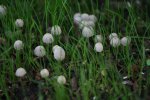I'm currently working on establishing an outdoor balcony garden/grazing area for my Russian tortoises. I've planted some grasses and a mix of other things in a planter box but due to what I'm assuming is a drainage issue, there have been very small white mushrooms popping up (maybe about 1/8 inch wide heads when fully open). I'm working on improving the drainage and their reproduction seems to slow and even stop as the soil dries out but once it's watered they start coming right back.
I live in the San Diego area and after looking at many photos on line, it seems they most resemble the genus coprinus. That is based on no preexisting knowledge of the subject and is just a best guess from what I've seen.
Is this something to be overly concerned about? I'm going to try to improve the drainage but I was wondering if I need to be worried about the health of my Russians once I start introducing them to this environment. I can take photos of the mushrooms if anyone might actually be able to identify them.
Thanks!
Patrick Del Pizzo
San Diego
I live in the San Diego area and after looking at many photos on line, it seems they most resemble the genus coprinus. That is based on no preexisting knowledge of the subject and is just a best guess from what I've seen.
Is this something to be overly concerned about? I'm going to try to improve the drainage but I was wondering if I need to be worried about the health of my Russians once I start introducing them to this environment. I can take photos of the mushrooms if anyone might actually be able to identify them.
Thanks!
Patrick Del Pizzo
San Diego

